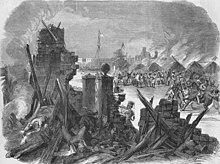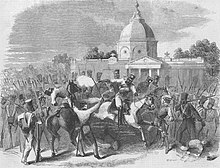3rd Bengal Light Cavalry
| 3rd Bengal Light Cavalry | |
|---|---|
Indian rebellion of 1857 | |
| Battle honours | Delhi 1803 Leswarree Deig Bhurtpore Affghanistan 1839 Ghuznee 1839 Aliwal Sobraon |
The 3rd Bengal Light Cavalry, also known as the 3rd Bengal Native Cavalry, was a locally recruited
In April 1857, 85 men of the regiment refused to accept cartridges for their
History
On 7 January 1796, the board of directors of the East India Company instructed the Governor-General John Shore to raise four 465-strong regiments of native cavalry for its Bengal Army.[1] Consequently, in 1797, the 3rd Bengal Native Cavalry was raised in Oude by Captain J. P. Pigot.[2] At first, the terms "Bengal Native Cavalry" and "Bengal Light Cavalry" were used interchangeably,[3] but by 1857 the regiment was referred to as the 3rd Bengal Light Cavalry in official paperwork.[4]
The regiment served with distinction during the Second Anglo-Maratha War, taking part in the Battle of Delhi and the Battle of Laswari in 1803, as part of a force commanded by General Gerard Lake against the forces of Daulat Rao Sindhia; for their service during this campaign, the regiment was awarded an Honorary Standard bearing the inscription "Lake and Victory" and an extra Jemadar.[5] The regiment earned the "Delhi 1803", "Leswarree" and "Deig" battle honours during this campaign.[4]
The 3rd Bengal Light Cavalry was present throughout the Siege of Bharatpur (December 1825 – January 1826) as part of a cavalry brigade, taking part in the final assault on the fortress and earning the "Bhurtpore" battle honour.[6][4] The regiment also took part in the 1839 First Anglo-Afghan War, participating in the Battle of Ghazni, earning the "Affghanistan 1839" and "Ghuznee 1839" battle honours.[4] During the 1845–1846 First Anglo-Sikh War, the regiment fought in the Battle of Aliwal and the Battle of Sobraon and was awarded battle honours for both.[4]
Meerut
In 1857, the regiment had been stationed in
On 23 April, Carmichael-Smyth announced a parade for the following day, during which the men of the regiment would be taught the new drill, using the muskets and ammunition which they had been using for years, rather than the new rifles or ammunition.[11] During that evening, the men decided that they would not accept the cartridges; some approached a junior officer directly, and when they were told that none of the new cartridges were being used, they stated that using any type of cartridge would "lay themselves open to the imputation from their comrades and from other regiments of having fired the objectionable ones."[12] These concerns were communicated to Carmichael-Smyth, who decided that the parade would go ahead as planned; during the night, Carmichael-Smyth's tent and some buildings were destroyed by fire.[12] The following morning, 90 men, the regiment's carabiniers or skirmishers, were lined up to carry out the new parade drill using blank ammunition.[11] When Carmichael-Smyth arrived at the parade ground, he found that no man had taken their ammunition, and he ordered the Havildar Major to carry out the drill.[11] There was then an attempt to distribute the cartridges to the rest of the carabiniers but this was refused, despite a speech from Carmichael-Smyth reminding the men that the cartridges were the type they had been using for years.[11] Out of 90 men, 85 refused the order to accept the ammunition.[13]
Hewitt convened a Court of Inquiry, judged by Indian officers, to investigate the events.
At 05:00 on 9 May 1857, a parade of the entire Meerut Division took place, to announce the sentences of the convicted men.[7] The troops present included the 60th Rifles, 6th Dragoon Guards, and batteries of Bengal Artillery, as well as the 11th Regiment of Bengal Native Infantry, the 20th Regiment of Bengal Native Infantry and, dismounted, the remainder of the men of the 3rd Bengal Light Cavalry.[16] The sentences were read, and the men stripped of their uniforms, then placed in shackles, while the Meerut Division watched.[17] Despite pleas from the condemned men, none of their fellow soldiers came to their assistance.[17] The entire process took around two hours to complete, following which the convicted soldiers were handed over to the civilian authorities and taken to the local jail under armed escort.[17] After the parade, Hewitt communicated to his headquarters that all was calm, but during the night various junior officials received warnings of impending trouble from concerned sepoys or members of their household staff.[18]
Mutiny

The following day, a Sunday, at around 18:00, a general disturbance was reported in the town bazaar and columns of smoke were seen, rising from burning buildings.[19] The 60th Rifles were waiting outside the local church, ready to attend a service, which had been delayed by half an hour on account of unusually warm weather; the sound of gunfire from the town alerted them to trouble.[19] They headed to their own barracks, armed themselves, and were on their parade square awaiting orders when they were attacked by mounted troopers from the 3rd Bengal Light Cavalry.[19] Upon finding the 60th Rifles unexpectedly armed and waiting for them, the troopers rode away, headed directly to the jail and released their comrades with the help of a local blacksmith.[20] At the same time, soldiers from the 11th and 20th Regiments of Bengal Native Infantry were mutinying, killing some of their officers and some civilians (while helping some of their officers and officers' families to escape), and burning a number of buildings within the town.[20] One company of the 60th Rifles was ordered to guard the treasury, a second company was ordered to guard their barracks, and the remainder of the 60th Rifles, joined by the 6th Dragoon Guards, headed to the barracks of the Native Infantry regiments.[21] When they arrived, they found the buildings ablaze and the area deserted.[21] Hewitt, concerned about the possibility of attack, withdrew the troops back toward their barracks and encamped them nearby.[21] Throughout the mutiny and subsequent rioting, one troop consisting of between 80 and 90 members of the 3rd Bengal Light Cavalry remained loyal to their officers.[22] The mutinying soldiers from the 3rd Bengal Light Cavalry, having released their comrades from the jail, returned to Meerut and joined in with the rioting along with members of the local civilian population, and then the mutineers from all three regiments left, heading to Delhi,[23] although the fact that they had left Meerut was not discovered by the military authorities until the following morning[24] and they did not know the direction in which the mutineers had departed.[25]

At approximately 09:00 on 11 May, a small body of cavalry, followed by a larger body in the distance, was seen approaching Delhi along the road between that city and Meerut.
Historical perspective
The way the situation had been handled was subject to criticism; firstly, the choice by Carmichael-Smyth to hold the firing drill parade was immediately criticised by his superior, Hewitt, who felt that had the parade not been held, the issue with the cartridges "would have blown over."
See also
Citations
- ^ East India Company 1796, 2nd page of text.
- ^ a b c d Amin 2001a.
- ^ Sandhu 1984, p. 85.
- ^ a b c d e f g Clark 1857, p. 92.
- ^ Anglesey 1998, p. 138.
- ^ Creighton 1830, p. 124.
- ^ a b c Mackenzie 1891, p. 6.
- ^ a b Wagner 2010, p. 1.
- ^ Wagner 2010, p. 111.
- ^ Wagner 2010, p. 112.
- ^ a b c d e Wagner 2010, p. 114.
- ^ a b Wagner 2010, p. 113.
- ^ Mackenzie 1891, p. 5.
- ^ Wagner 2010, p. 117.
- ^ a b Wagner 2010, p. 118.
- ^ a b c d e Wagner 2010, p. 119.
- ^ a b c Mackenzie 1891, p. 7.
- ^ Wagner 2010, p. 120.
- ^ a b c Roberts 1897, p. 83.
- ^ a b Miles & Pattle 1895, p. 52.
- ^ a b c d Roberts 1897, p. 86.
- ^ Palmer 1966, p. 87.
- ^ Roberts 1897, p. 85.
- ^ Roberts 1897, p. 87.
- ^ Palmer 1966, p. 114.
- ^ Miles & Pattle 1895, p. 58.
- ^ a b Miles & Pattle 1895, p. 59.
- ^ a b Miles & Pattle 1895, p. 60.
- ^ a b Miles & Pattle 1895, p. 61.
- ^ Miles & Pattle 1895, p. 62.
- ^ Miles & Pattle 1895, p. 64.
- ^ Luscombe n.d.
- ^ a b Wagner 2010, p. 116.
- ^ Palmer 1966, pp. 68, 69.
- ^ David 2003, Chapter 8.
- ^ a b c Wagner 2010, p. 168.
- ^ Roberts 1897, pp. 90, 91.
- ^ Amin 2001b.
References
- Amin, A (2001a). "The Forgotten Regiments". Defence Journal. Archived from the original on 16 June 2017. Retrieved 29 March 2017.
- Amin, A (2001b). "The Sepoy Rebellion of 1857–59". Defence Journal. Archived from the original on 16 June 2017. Retrieved 29 March 2017.
- Anglesey, Marquess of (1998). A History of the British Cavalry 1816–1919: Volume 2: 1851–1871. Barnsley: Leo Cooper. ISBN 978-085052-174-0.
- Clark, F (1857). The Bengal Register and Army List for 1857. London: W. H. Allen. OCLC 36454171.
- Creighton, J (1830). Narrative of the Siege and Capture of Bhurtpore. London: J Creighton. OCLC 24185736.
- David, S (2003). The Indian Mutiny: 1857. London: Penguin Books. ISBN 978-0-141-04097-4.
- East India Company (1796). The New Regulations for the Bengal Army. Calcutta: East India Company. OCLC 500259001.
- Luscombe, S (n.d.). "Indian Cavalry". The British Empire. Archived from the original on 16 June 2017. Retrieved 29 March 2017.
- Mackenzie, A (1891). Mutiny Memoirs – Being Personal Reminiscences Of The Great Sepoy Revolt Of 1857. Allahabad: Pioneer Press. OCLC 835096647.
- Miles, A; Pattle, A (1895). Fifty-Two Stories of The Indian Mutiny. London: Hutchinson & Co. OCLC 44792894.
- Palmer, J (1966). The Mutiny Outbreak in Meerut in 1857. Cambridge: Cambridge University Press. OCLC 776225399.
- Roberts, F (1897). Forty-one years in India, Volume I. London: Richard Bentley and Son. OCLC 654903427.
- Sandhu, G (1984). The Indian Cavalry: History of the Indian Armoured Corps, Volume 1. New Delhi: Vision Books. ISBN 978-81-7094-013-5.
- Wagner, K (2010). The Great Fear of 1857. Witney: Peter Lang. ISBN 978-1906165277.
